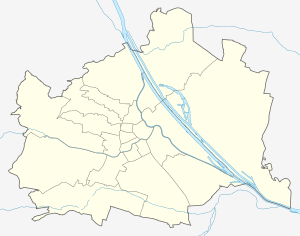Floridsdorf Bridge
Coordinates: 48 ° 14 ′ 51 ″ N , 16 ° 23 ′ 7 ″ E
| 226 Floridsdorf Bridge | ||
|---|---|---|
| View upstream of the Floridsdorfer Brücke (bridge over the Danube) | ||
| use | Tram, tram, bicycle and pedestrian bridges | |
| Convicted | Floridsdorfer Strasse | |
| Crossing of |
Danube New Danube |
|
| place | Vienna | |
| overall length | 332, 50 meters | |
| width | 31.40 meters | |
| location | ||
|
|
||
The Floridsdorfer Brücke is a road bridge over the Danube in Vienna . It connects the two Viennese districts of Brigittenau and Floridsdorf .
It has two lanes in both directions. Downstream there is a five-meter-wide footpath and bike path and the track for the tram. In the area of the river bridge the total width is 31.4 meters, in the area of the flood bridge 37.4 meters.
Structures
The bridge is divided into four parts:
- the quay bridge, it is approx. 95 meters long and bridges the Handelskai and the Donauuferbahn and is designed as a prestressed concrete structure with hollow boxes,
- the river bridge with a steel structure with a length of 332.5 meters,
- the flood bridge, also with a steel structure with a length of 215 meters,
- and the junction plate above the Danube bank motorway A22.
In addition to road traffic, the Schottenring – Stammersdorf tram route, as well as a footpath and a cycle path, cross the bridge.
history
The beginnings of the Danube crossing in the area of today's structure go back to the 15th century, when a wooden bridge structure crossed the Danube. In the course of time, various Danube crossings were made, which were later removed. During the work on the Danube regulation, the construction of the Kaiser-Franz-Joseph Bridge began in 1872 . The grand opening took place two years later. But as early as 1904 when Floridsdorf was incorporated, the bridge no longer met the requirements. In addition, it had only a narrow, only 6.7 meters wide carriageway and the height from the bridge down to the water was 17.6 meters. On June 28, 1913, in the presence of Emperor Franz Joseph I, the foundation stone was laid for a renovation of the Emperor Franz Joseph Bridge . Due to the First World War , the construction was delayed, so that partial operation for the tram was only released on December 21, 1922. On June 25, 1924, the new structure described as a renovation (in the presence of Trade and Transport Minister Hans Schürff ) was opened as the Floridsdorf Bridge .
When the German Wehrmacht withdrew , the bridge was blown up on the night of April 13-14, 1945. The bridge was initially replaced by a wooden footbridge, but reconstruction began as early as autumn 1945. In occupied Austria of the first anniversary of the liberation of Vienna was Floridsdorfer bridge renamed on 11 April 1946 in the occasion Malinowski bridge after the supreme commander of the 2nd Ukrainian Front , which had conquered Vienna from the north. On May 19, 1946, the restored bridge was finally opened to traffic. On July 18, 1956, the municipal council committee for culture and public education decided to rename the building to Floridsdorfer Brücke .
One consequence of the collapse of the Reichsbrücke were large-scale investigations of all bridges. At the Floridsdorfer Bridge, too, major defects were found on one of the bridge piers, which led to the immediate closure on December 23, 1976. This led to major problems, as the new Reichsbrücke was not yet finished either. It was therefore makeshift repairs for trams and emergency vehicles up to 16 tons total weight as well as for pedestrians and cyclists. The tram tracks were moved to the better-preserved part of the bridge located downstream. From April 2, 1977, the tram lines 132, 231 and 331 could use the bridge again.
At the same time, construction began in April 1977 upstream just next to the old bridge. It opened on October 3rd, 1978.
photos
Individual evidence
- ↑ a b for the entire section: Online presence of the City of Vienna Details on the Floridsdorfer Bridge.
- ↑ Laying of the foundation stone for the renovation of the Kaiser Franz Joseph Bridge. In: Wiener Zeitung , supplement Wiener Abendpost , No. 147/1913, June 28, 1913, p. 5 f. (Online at ANNO ). .
- ^ From the new construction of the Floridsdorfer Bridge. In: Wiener Zeitung , No. 284/1922, December 23, 1922, p. 8, top left. (Online at ANNO ). .
- ↑ Municipal newspaper . The opening of the Floridsdorfer Bridge. In: Neue Freie Presse , Morgenblatt, No. 12477/1924, June 26, 1924, p. 7, bottom right. (Online at ANNO ). .
- ↑ On the day of liberation. Street names in honor of the Red Army . In: Arbeiter-Zeitung . Vienna April 12, 1946, p. 1 , top left ( berufer-zeitung.at - the open online archive - digitized).
- ↑ From day to day. (...) The opening of the Malinowski Bridge . In: Arbeiter-Zeitung . Vienna May 21, 1946, p. 3 , column 2 above ( berufer-zeitung.at - the open online archive - digitized).
- ↑ By general request: The Russian street names abolished. Stalinplatz is again called Schwarzenbergplatz . In: Arbeiter-Zeitung . Vienna July 19, 1956, p. 1 , above ( berufer-zeitung.at - the open online archive - digitized).
Web links
- Web service of the City of Vienna: Floridsdorfer Brücke.








